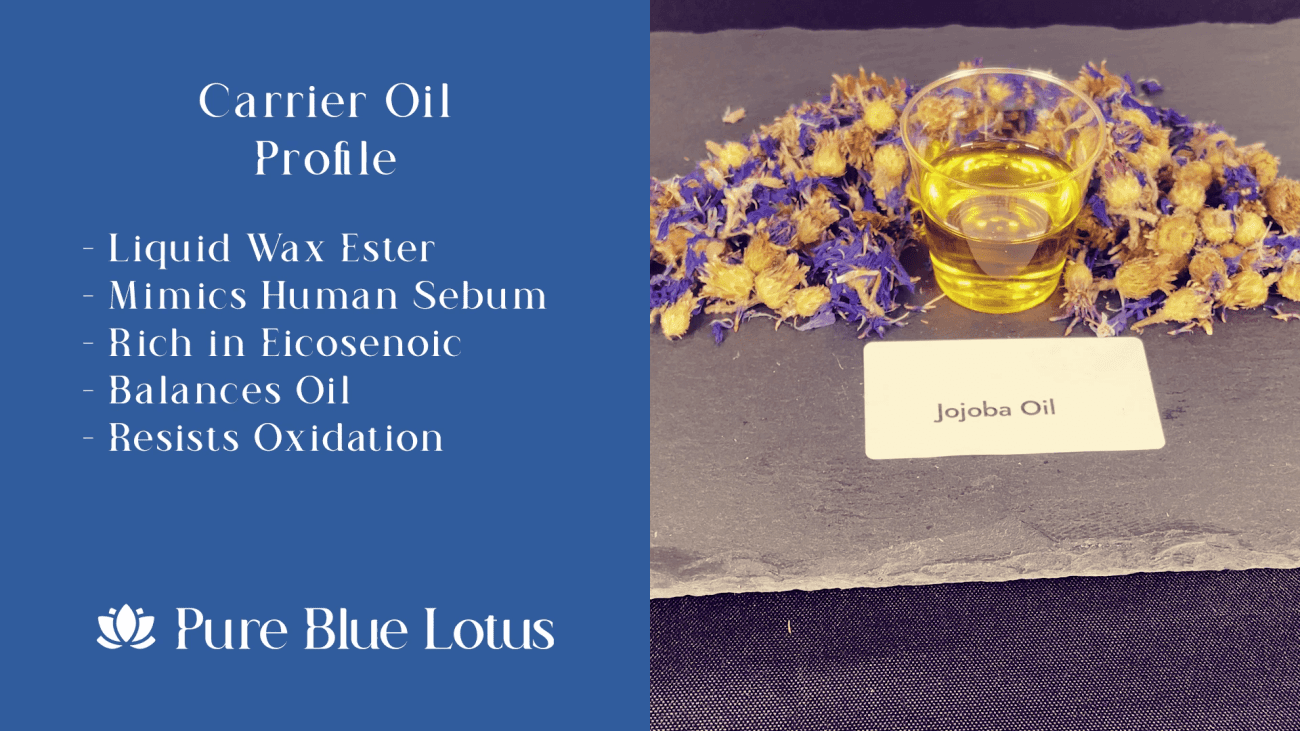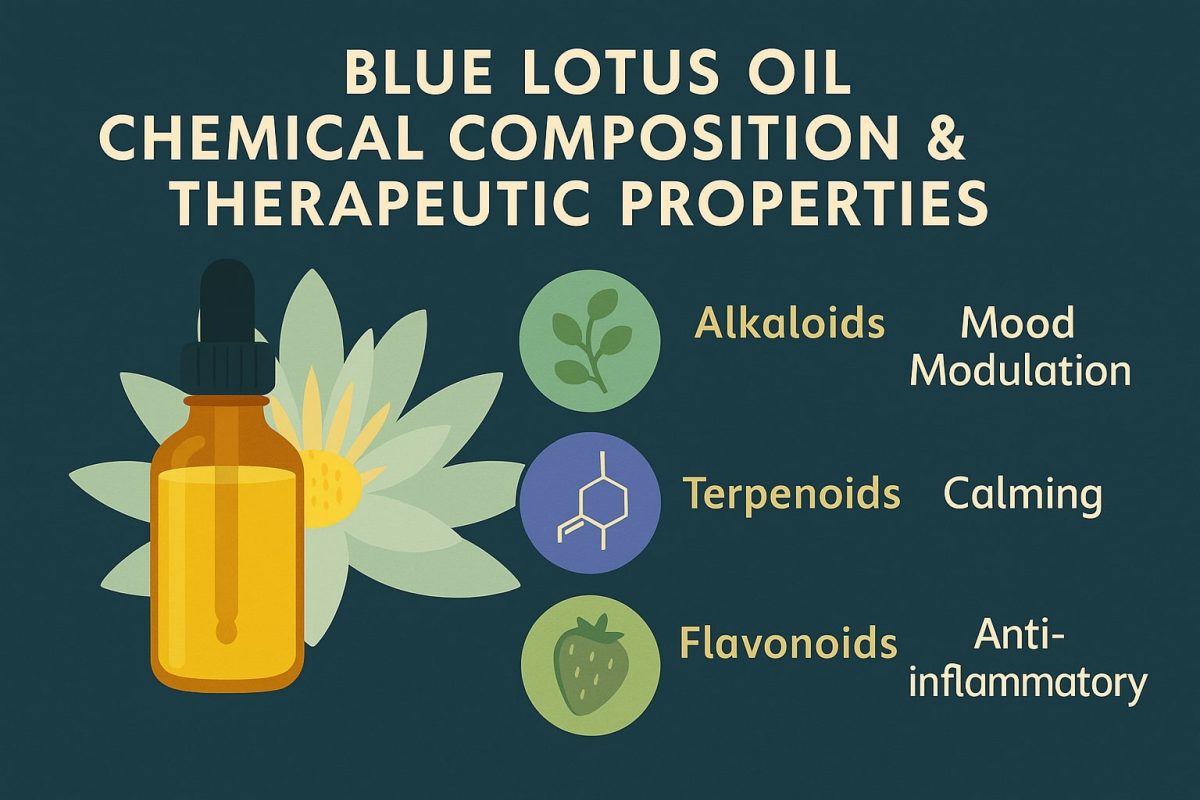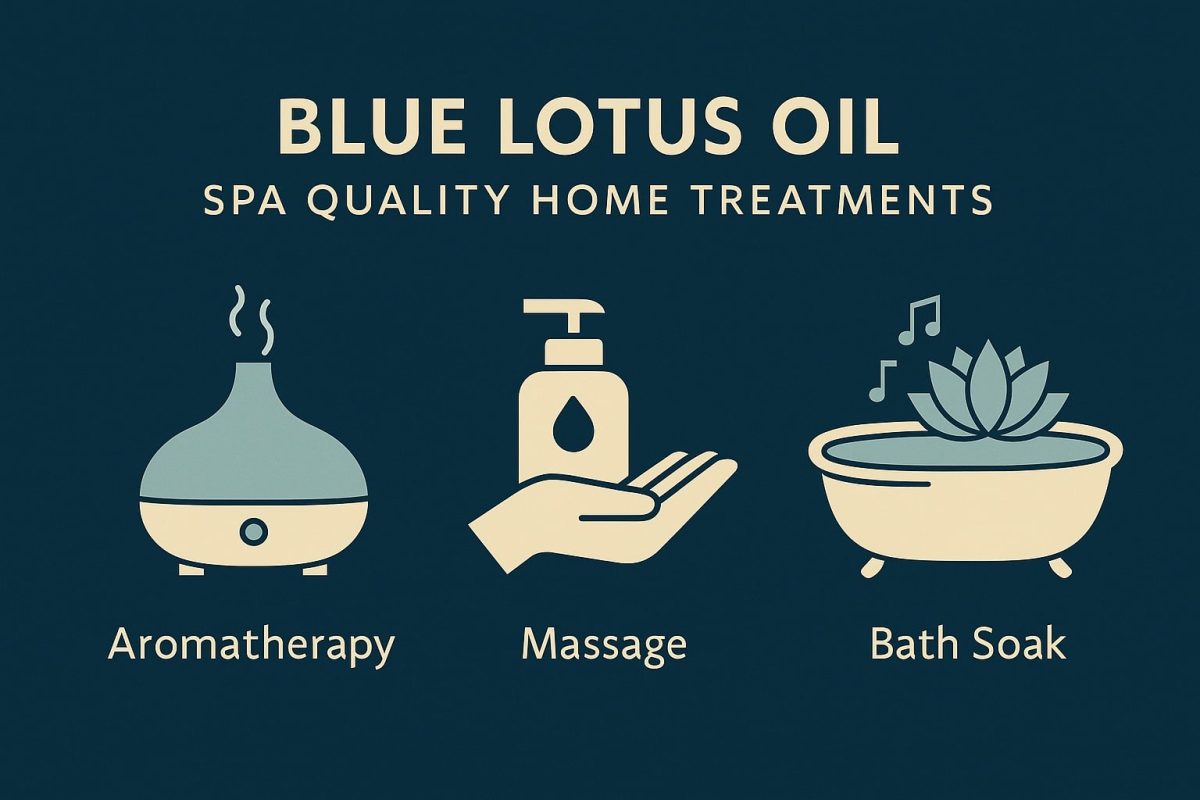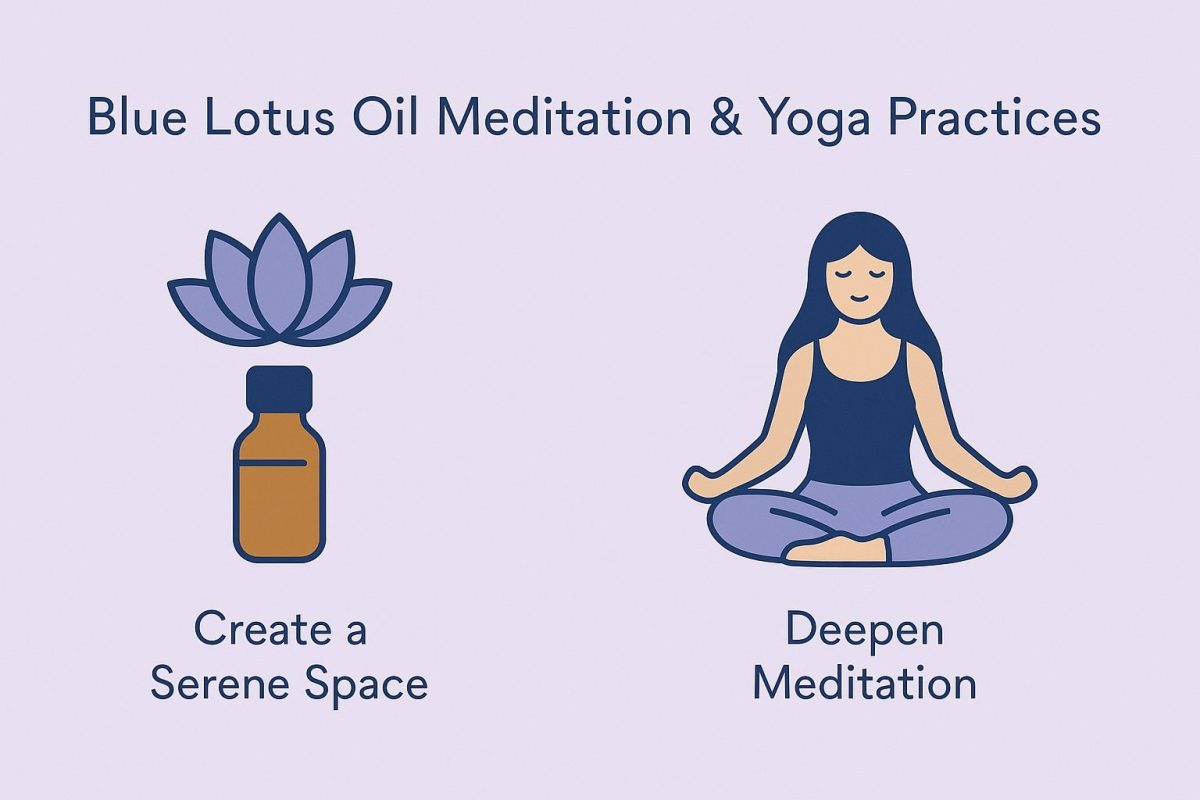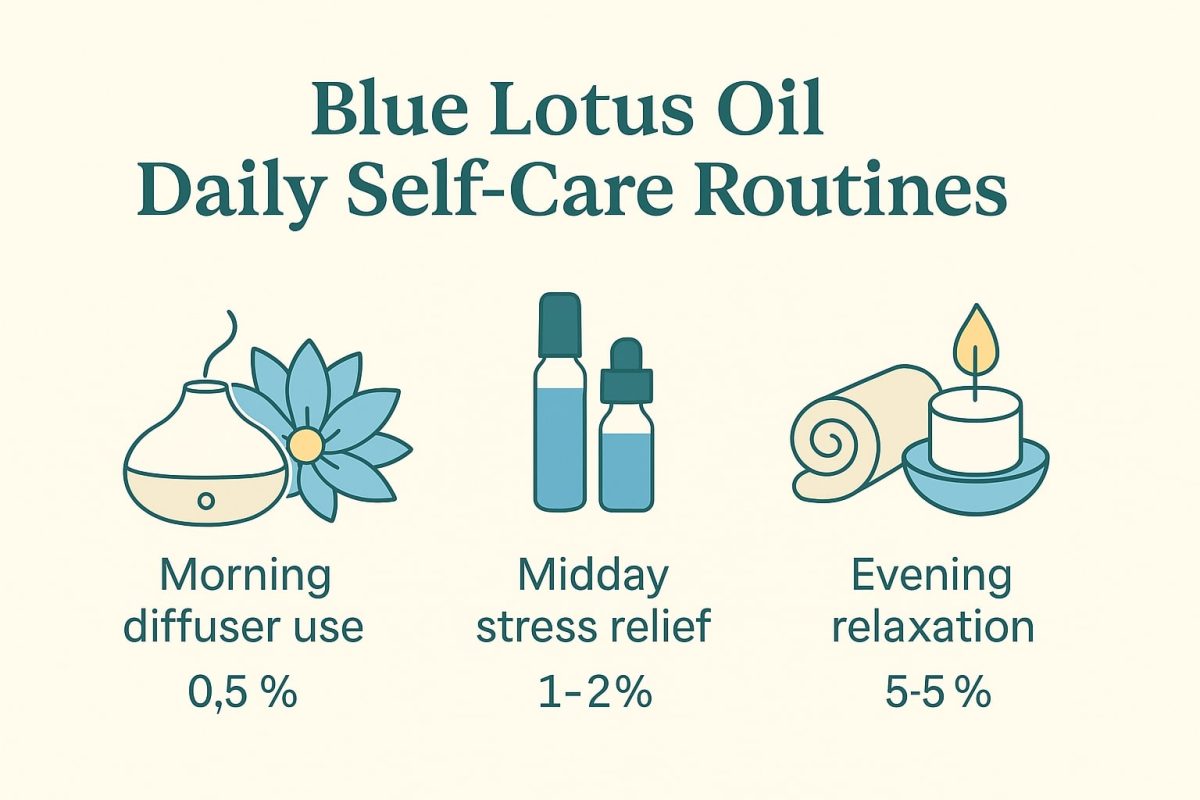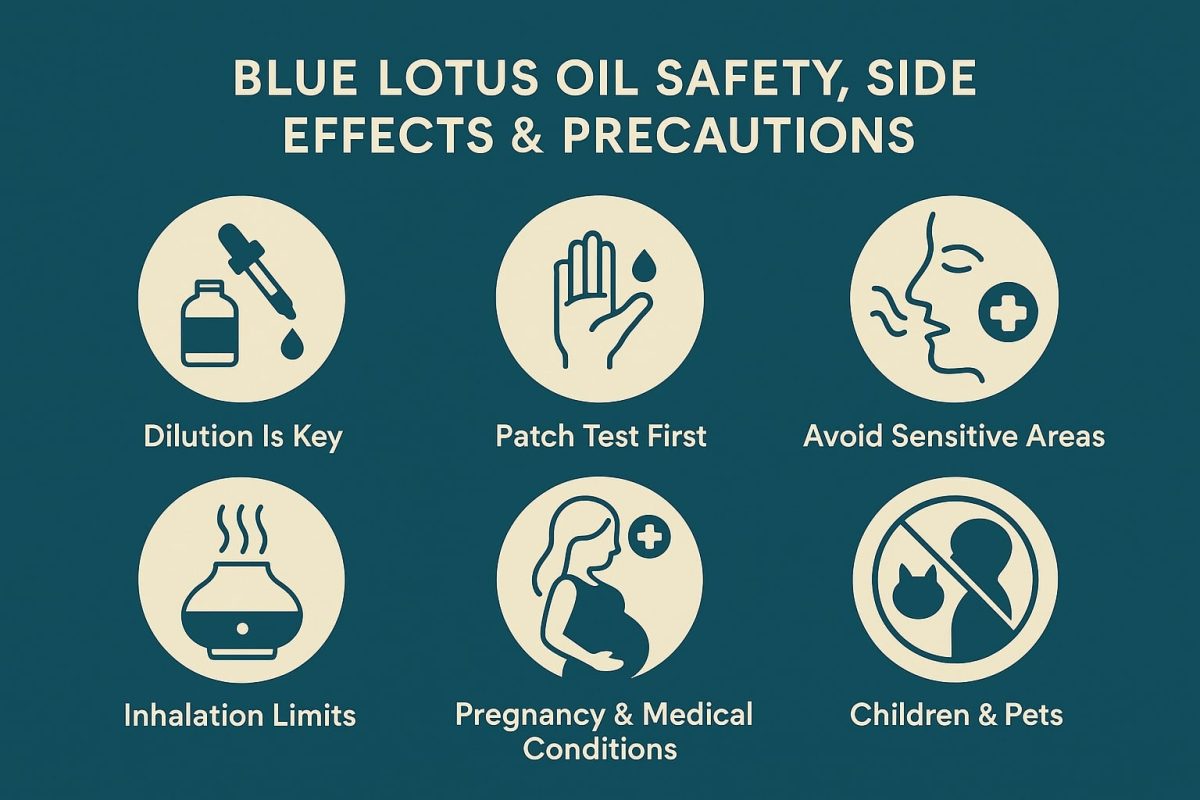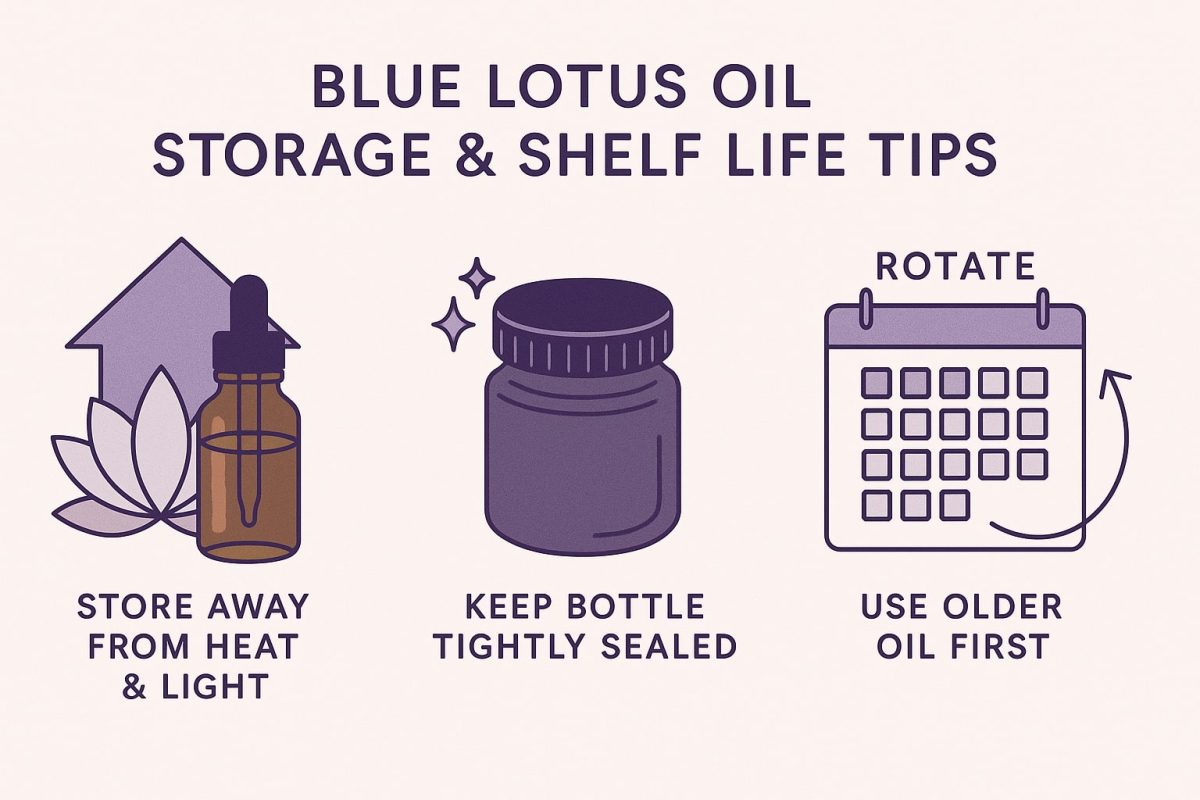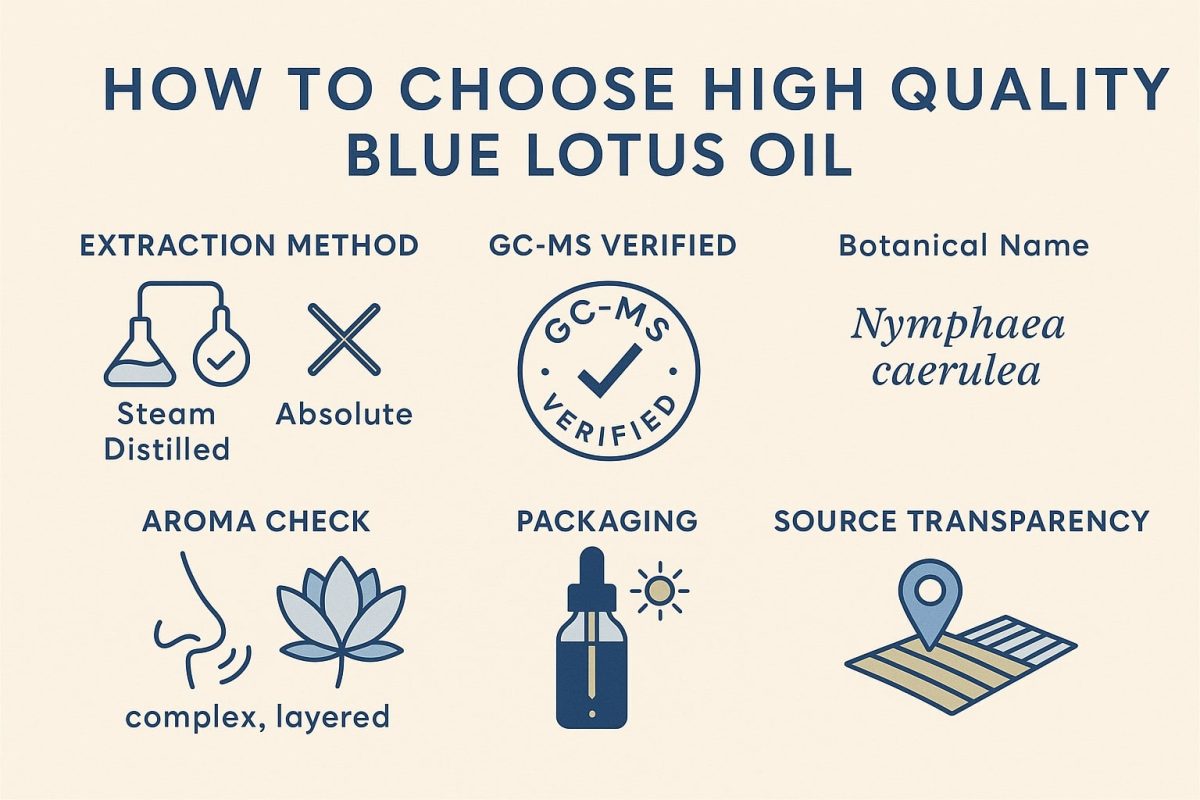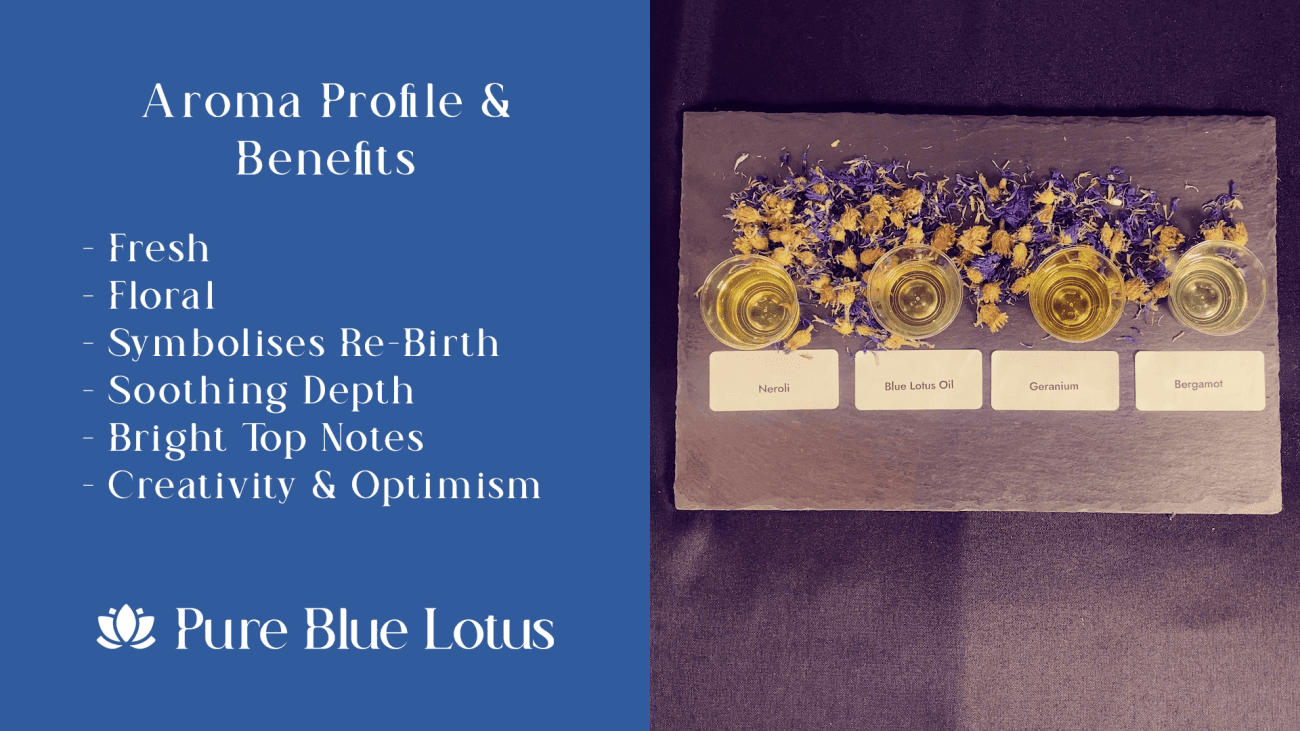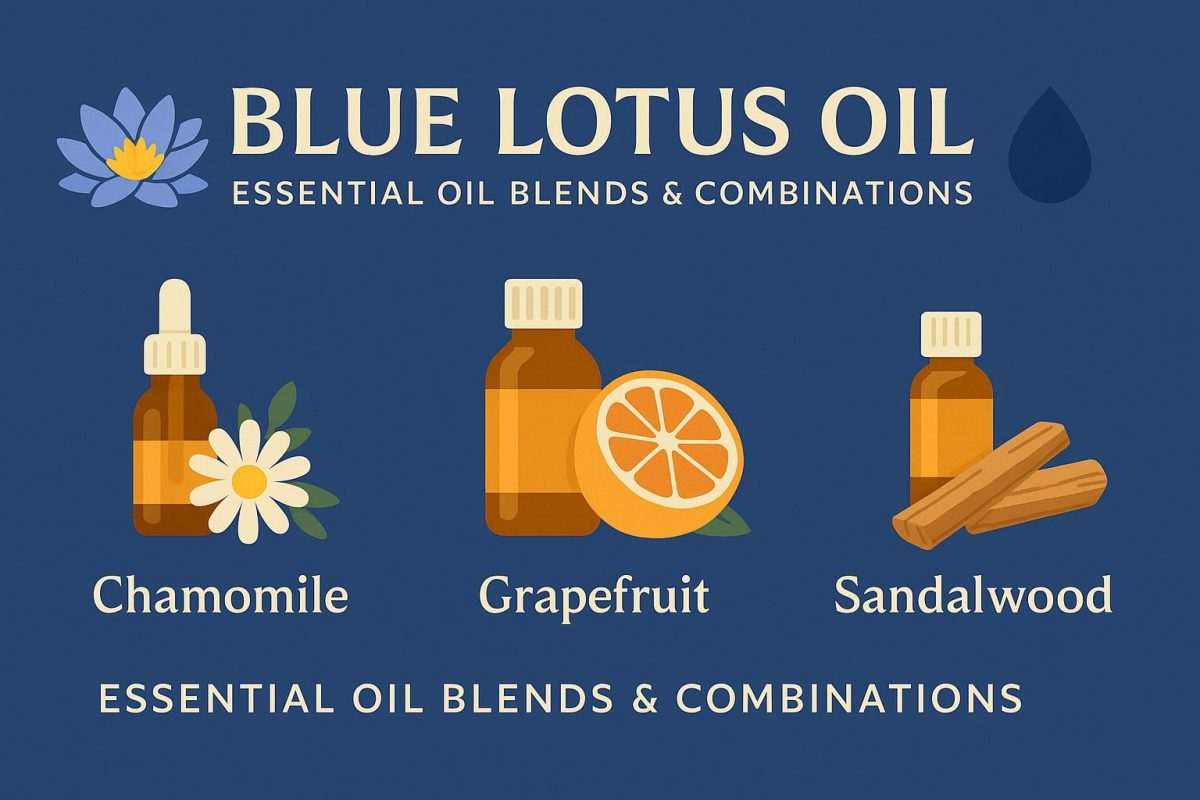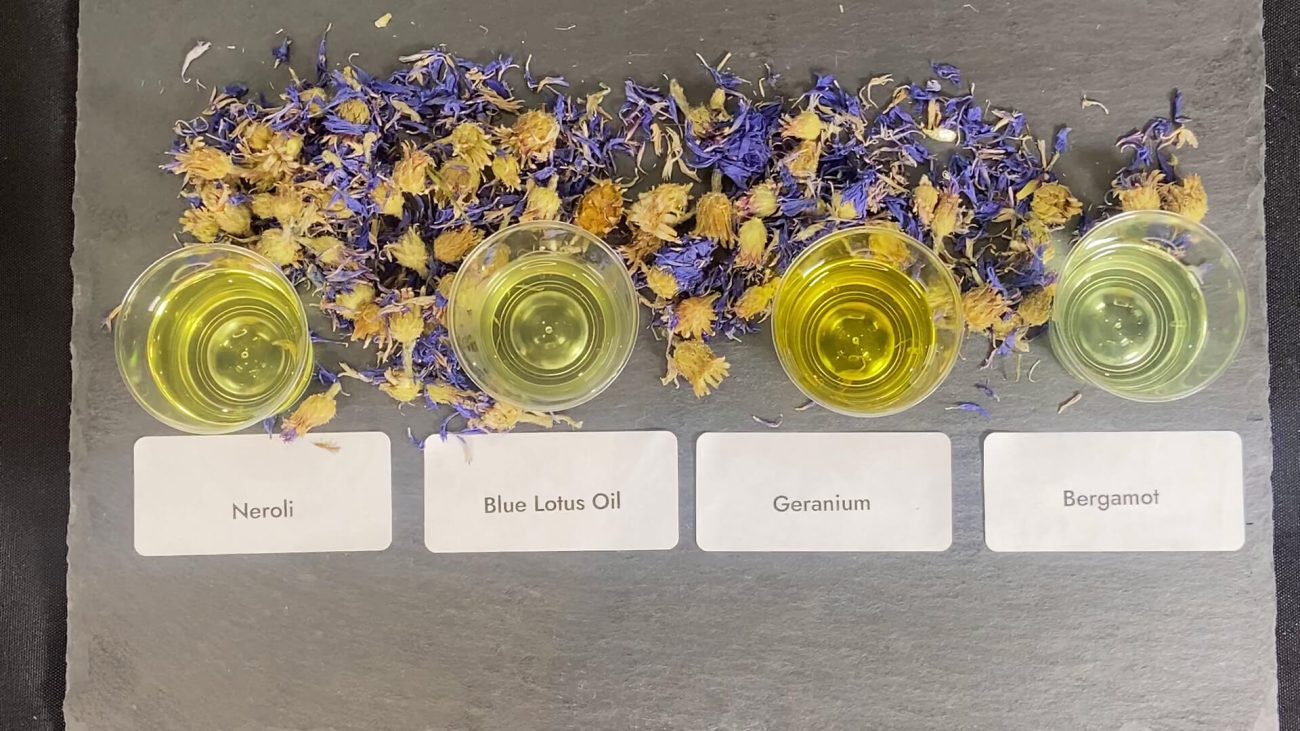Organic Blue Lotus Essential Oil
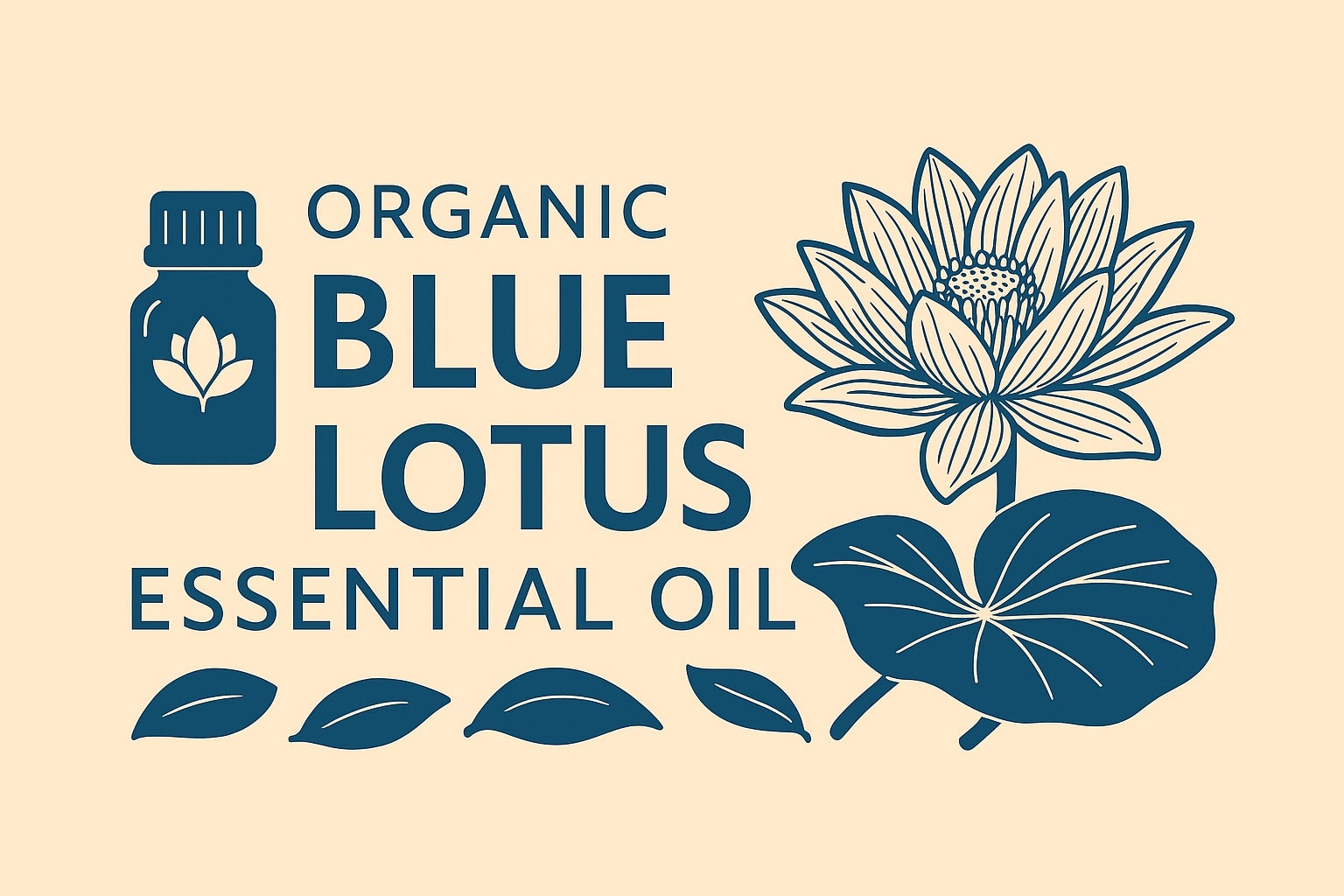
Organic Blue Lotus Essential Oil is a premium botanical extract derived from the petals of the blue lotus flower (Nymphaea caerulea). Renowned since antiquity for its soothing floral aroma and myriad therapeutic effects, this oil supports relaxation, emotional balance, skin and hair health, and spiritual practice. In this guide, you will learn about its botanical heritage, traditional uses, modern extraction techniques, chemical profile, evidence‑based benefits, recommended applications, quality standards, pricing considerations, safety guidelines, and answers to frequently asked questions.
For those seeking the finest, the highest quality Blue Lotus Oil, experience our hand-crafted, pure Luxury Egyptian Blue Lotus Oil (Nymphaea Caerulea) for a truly luxurious addition to your wellness routine. Find out more →
Quick Links to Useful Sections
- Botanical Origins and Cultivation
- Historical and Cultural Significance
- Extraction Methods and Quality Grades
- Chemical Composition and Therapeutic Actions
- Evidence-Based Benefits
- Stress Reduction and Relaxation
- Mental Clarity and Creativity
- Skin Rejuvenation and Anti‑Aging
- Pain and Muscle Tension Relief
- Meditative and Spiritual Enhancement
- Aphrodisiac and Emotional Uplift
- Practical Applications and Rituals
- Aromatherapy Diffusion
- Topical Massage Blend
- Bath and Body Soak
- Facial Serum and Moisturizer Booster
- Hair and Scalp Treatment
- Meditation Anointing
- Quality Standards and Certification
- Pricing and Value Considerations
- Safety Guidelines and Precautions
- Frequently Asked Questions
Botanical Origins and Cultivation
The blue lotus flower, also known as the Egyptian water lily, grows naturally in the still waters of the Nile basin and wetland regions of East Africa and Southeast Asia. It thrives in warm, tropical climates, producing large, cerulean‑blue petals that open at dawn and close by afternoon. Cultivation today often occurs on small organic family farms that hand‑harvest fully‑bloomed flowers each morning. Sustainable farming practices include water management to maintain pH balance, use of organic composts for soil fertility, and avoidance of pesticides or synthetic fertilizers to preserve delicate aromatic compounds.
Once harvested, petals are sorted to remove any damaged or discolored blooms. They are then gently washed in purified water to eliminate debris and air‑dried in shaded, ventilated facilities to retain color and fragrance. Cold storage at controlled humidity ensures petals remain fresh until extraction begins, typically within 24 to 48 hours of harvest to prevent enzymatic degradation of key constituents.
Commission your made-to-order bottle of pure, undiluted Egyptian Blue Lotus Oil (Nymphaea Caerulea)
Commission your made-to-order bottle of pure, undiluted Egyptian Blue Lotus Oil (Nymphaea Caerulea)
Historical and Cultural Significance
Archaeological sites along the Nile reveal blue lotus motifs carved into temple walls and painted on ceramics dating back to 2500 BCE. Ancient Egyptians associated the flower with the sun god Ra, linking its daily blooming cycle to creation and rebirth. Lotus‑infused oils and unguents appear in tombs alongside pharaonic mummies, suggesting ritual bathing and aromatic anointing to facilitate journey into the afterlife. Greek and Roman scholars adopted blue lotus in medicinal remedies for insomnia, anxiety, and mild pain relief. The flower also appears in Ayurvedic and Tibetan texts, where it was prescribed to balance vata and pitta doshas, promote restful sleep, and deepen meditation.
Over centuries, the symbolic resonance of the blue lotus endured in art, literature, and spiritual ceremony. Today, modern aromatherapists and holistic practitioners draw on this heritage to design rituals that combine scent, breathwork, and mindful touch, harnessing both traditional wisdom and contemporary science.
Extraction Methods and Quality Grades
While steam distillation is commonly used for essential oils, the delicate aromatics of blue lotus often degrade under high heat. To preserve the full spectrum of volatile terpenes, flavonoids, and alkaloids, several extraction methods are employed:
- Cold pressing of fresh petals produces a viscous, golden‑yellow oil rich in non‑volatile waxes, fatty acids, and phytoactives. This “raw” oil retains both water‑ and oil‑soluble compounds, but yields are lower per batch.
- Steam distillation yields a lighter essential oil with bright floral high notes but may lose heavier constituents. It is often used to create blends where a crisper aroma is desired.
- CO₂ supercritical extraction uses carbon dioxide under high pressure and low temperature to solubilize both volatile and semi‑volatile compounds, producing an absolute or resinous extract that bridges the gap between essential oil and concrete.
- Solvent extraction (typically with ethanol or hexane) captures a broad phytochemical range, then undergoes purification to remove solvent traces. The resulting absolute has a richer scent but may command a premium price due to additional processing.
Each method yields distinct aroma profiles and therapeutic spectra. Cold‑pressed organic blue lotus oil is prized for full‑spectrum potency, CO₂ extracts shine in perfumery, and steam‑distilled oils excel in crisp aromatherapy blends.
Chemical Composition and Therapeutic Actions
Comprehensive phytochemical analysis reveals that organic blue lotus essential oil contains:
- Apomorphine and nuciferine alkaloids that interact with dopamine pathways to support mild euphoria, motivation, and neuroprotection.
- Flavonoids such as quercetin, kaempferol, and isorhamnetin that provide antioxidant, anti‑inflammatory, and vascular‑supporting effects.
- Monoterpenes and sesquiterpenes, linalool, limonene, geraniol, and nerolidol, that exhibit anxiolytic, analgesic, antimicrobial, and anti‑spasmodic properties.
- Fatty acids, linoleic, oleic, palmitic, and stearic, that nourish the skin barrier, promote moisture retention, and deliver lipophilic actives to deeper layers.
- Wax esters and phytosterols that create a protective emollient film on skin and support cellular membrane integrity.
The combined actions of these molecules produce multi‑modal effects when inhaled, applied topically, or used in ritual: reduction of stress hormones, enhancement of neuroplasticity, mitigation of oxidative damage, soothing of irritated tissues, and facilitation of meditative states.
Evidence-Based Benefits
Stress Reduction and Relaxation
Clinical and preclinical studies demonstrate that inhalation of blue lotus aroma can lower heart rate and cortisol levels, promoting a calm, centered state. A randomized trial found that participants who breathed blue lotus essential oil for 15 minutes before bedtime reported improved sleep onset and reduced anxiety scores compared to a control group.
Mental Clarity and Creativity
The mild dopaminergic activity of apomorphine derivatives in blue lotus supports focus, motivation, and creative problem‑solving. Aromatherapists often recommend blue lotus during brainstorming sessions or artistic endeavors to sustain engagement without overstimulation.
Skin Rejuvenation and Anti‑Aging
Topical formulations containing blue lotus extract or oil have been shown to enhance collagen synthesis, reduce transepidermal water loss, and protect keratinocytes from UV‑induced oxidative stress. Users report improved skin tone, elasticity, reduction of fine lines, and relief from inflammatory conditions such as eczema and psoriasis.
Pain and Muscle Tension Relief
Blue lotus oil’s antispasmodic and analgesic terpenes make it effective when used in massage blends for sore muscles, tension headaches, and menstrual cramps. A pilot study indicated that a 2% topical blue lotus oil massage reduced subjective pain ratings by 40% after a single session in participants with chronic tension headaches.
Meditative and Spiritual Enhancement
Traditional meditators anoint pulse points with blue lotus oil to deepen trance states and support introspective awareness. Neuroimaging research suggests that inhalation of certain aromatic compounds can modulate alpha‑wave activity in the brain, correlating with relaxed alertness and heightened sensory perception.
Aphrodisiac and Emotional Uplift
Historical accounts and modern surveys confirm that blue lotus aroma can enhance feelings of sensuality, reduce social anxiety, and improve emotional intimacy. Its mood‑lifting terpenes assist in creating an intimate, harmonious atmosphere.
Practical Applications and Rituals
Aromatherapy Diffusion
Add 3–5 drops of organic blue lotus essential oil to an ultrasonic diffuser filled with clean water. Diffuse for 30–60 minutes in your bedroom, meditation room, or workspace to create a serene, uplifting environment.
Topical Massage Blend
Combine 5 ml of blue lotus oil with 25 ml of sweet almond or jojoba carrier oil. Massage into temples, shoulders, lower back, or feet using gentle, circular motions. This ritual soothes muscle tension and anchors attention in the body.
Bath and Body Soak
Mix 6–8 drops of oil with a half‑cup of Epsom or Himalayan salt. Swirl into warm bathwater and soak for 20–30 minutes while breathing deeply. The combination of mineral salts and floral aromatics calms the nervous system and nourishes skin.
Facial Serum and Moisturizer Booster
Add 2–3 drops of organic blue lotus oil to your nightly facial serum or moisturizer. Gently press into clean skin using upward strokes. The oil enhances hydration, supports overnight repair, and leaves a subtle, calming scent.
Hair and Scalp Treatment
Warm 5 ml of pure blue lotus oil in your palms and massage into scalp and hair ends. Wrap hair in a warm towel for 30–60 minutes before shampooing. This ritual supports follicle health, reduces dryness, and imparts a natural luster.
Meditation Anointing
Place one drop on each temple and the center of the forehead (third eye). Inhale deeply three times before beginning your meditation practice. The oil’s psychoactive alkaloids assist in settling mental chatter and expanding awareness.
Quality Standards and Certification
To ensure authenticity and efficacy, seek organic blue lotus essential oil with the following credentials:
- Certified organic by USDA, ECOCERT, or equivalent bodies.
- Cold‑pressed or CO₂‑extracted to preserve full phytochemical spectrum.
- Third‑party GC‑MS (gas chromatography–mass spectrometry) reports verifying chemical profile and absence of contaminants or adulterants.
- Fair trade or equitable sourcing partnerships with local communities.
- Opaque, UV‑protected packaging to maintain stability of sensitive compounds.
Avoid oils labeled simply “fragrance oil” or “blend,” which often contain synthetic aroma chemicals rather than genuine botanical extract.
Pricing and Value Considerations
Organic blue lotus essential oil commands a premium price due to low yield (often requiring 100–200 kg of petals per liter of oil), labor‑intensive harvest, and specialized extraction. Typical retail prices (subject to regional variation) include:
- 5 ml dropper bottle: €35–50 / $40–60
- 10 ml amber glass vial: €65–90 / $75–100
- 30 ml eco‑refill pouch: €180–220 / $200–250
Investing in high‑quality oil ensures superior aroma, potency, and therapeutic benefit. Look for bundle offers or subscription options from reputable brands to reduce per‑milliliter cost and guarantee regular replenishment.
Safety Guidelines and Precautions
Although generally well tolerated, follow these safety recommendations:
- Perform a patch test: apply one drop diluted in carrier oil behind the ear or inner forearm; wait 24 hours to check for irritation.
- Avoid contact with eyes, sensitive mucous membranes, and broken skin.
- Do not ingest unless under guidance of a qualified aromatherapist or healthcare professional.
- Consult a physician before use if pregnant, nursing, or taking medications that affect neurotransmitter systems.
- Store oil in a cool, dark place away from direct sunlight to preserve stability.
- Use within 12 months of opening to ensure freshness and potency.
Frequently Asked Questions
How should I store organic blue lotus essential oil?
Keep the bottle tightly closed in a cool, dark cabinet or drawer. Avoid heat sources and direct sunlight, which can accelerate oxidation and degrade aroma.
Can I blend blue lotus oil with other essential oils?
Yes, blue lotus pairs beautifully with lavender, sandalwood, frankincense, rose, and citrus oils. Maintain total essential oil concentration below 5% when diluting in carrier oils for topical use.
How many drops should I use in a diffuser?
Start with 3–5 drops in 100–200 ml of water for an ultrasonic diffuser. Adjust based on room size and personal sensitivity to aroma intensity.
Is it safe to apply directly to my skin?
Always dilute blue lotus essential oil in a suitable carrier oil at a minimum ratio of 2–5% (2–5 drops per 5 ml carrier). Pure undiluted oil may cause irritation in sensitive individuals.
Does blue lotus essential oil have psychoactive effects?
It contains mild alkaloids that can induce gentle euphoria and relaxation but is not comparable to strong psychoactive or narcotic substances. Effects are subtle and support wellness rituals.
Where can I purchase authentic organic blue lotus essential oil?
Look for specialized aromatherapy brands, certified organic wellness retailers, or reputable online platforms that provide GC‑MS reports, organic certification, and fair trade sourcing information.
For those seeking the finest, the highest quality Blue Lotus Oil, experience our hand-crafted, pure Luxury Egyptian Blue Lotus Oil (Nymphaea Caerulea) for a truly luxurious addition to your wellness routine. Find out more →

